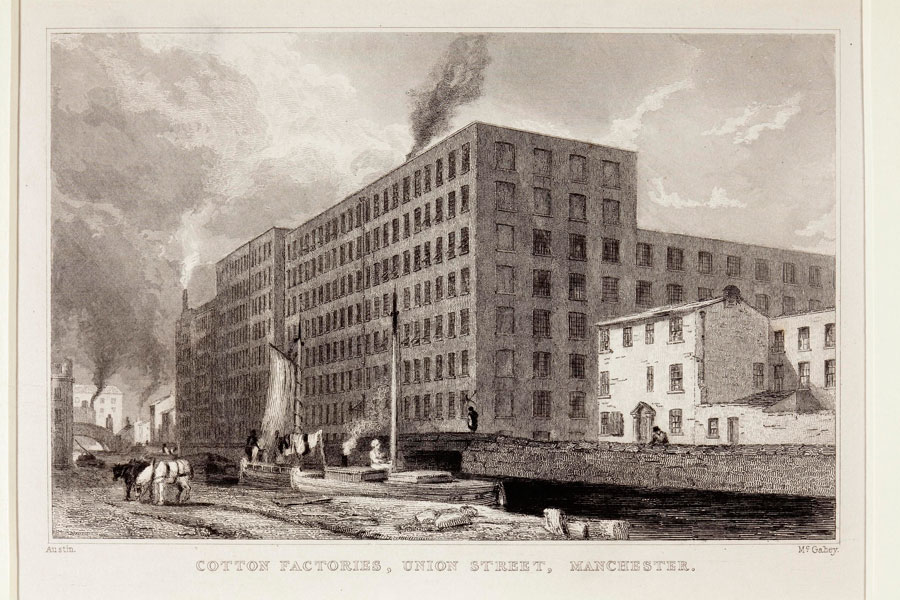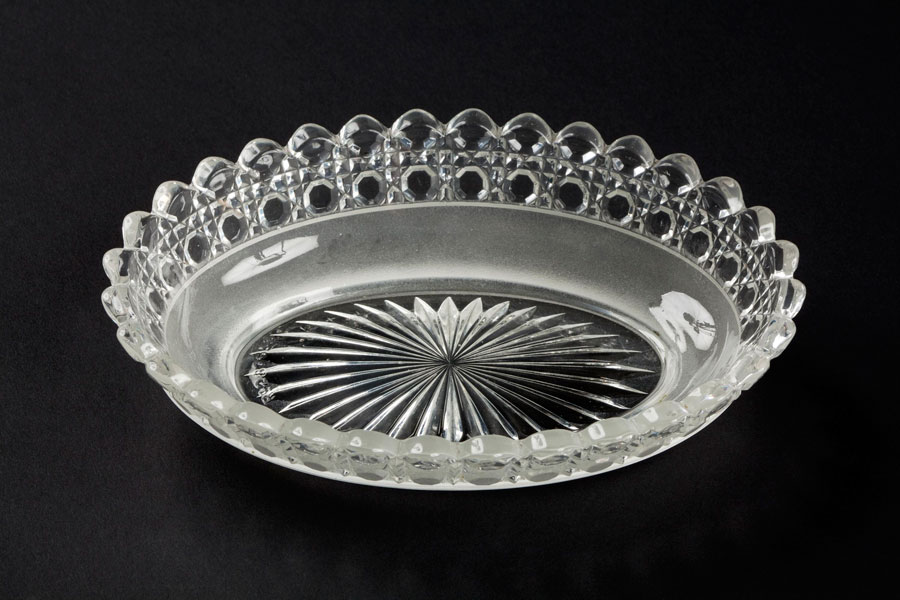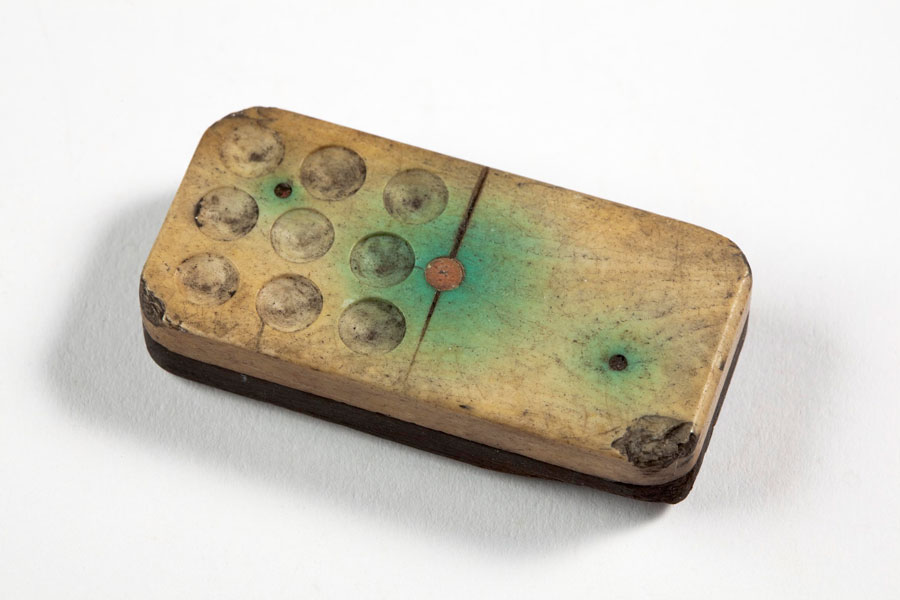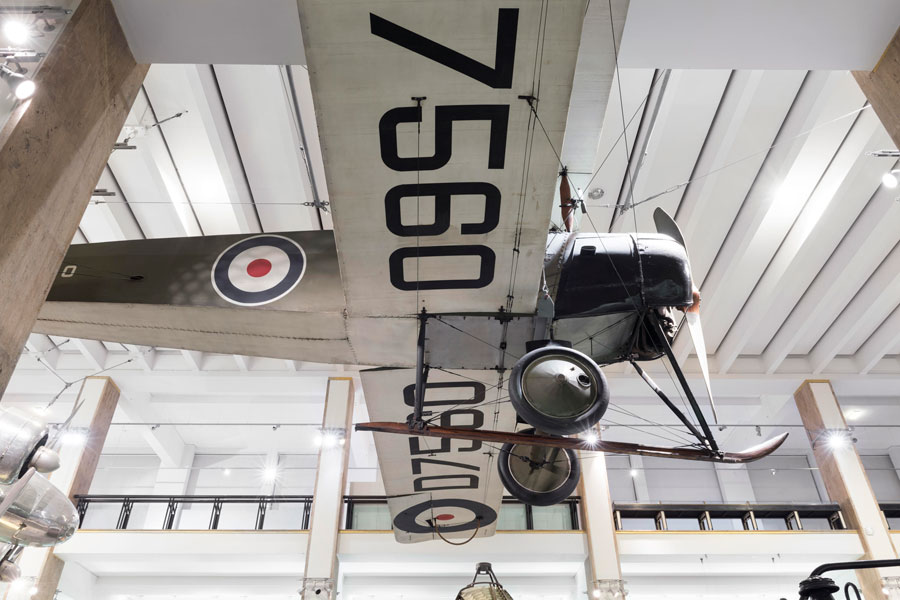A more perfectly ugly spot you shall not find between sunrise and sunset. Fancy a street, one side of which is all mills, huge square piles of mills, with six, seven and eight tiers of foul and blackened windows, the grimiest, sootiest, filthiest lumps of masonry in all Manchester…
This was Union Street in Ancoats in 1849, as described by journalist Angus Reach in the Morning Chronicle. By then, as part of Manchester’s burgeoning industrialisation, Ancoats, just east of the city centre, had grown rapidly from an unremarkable hamlet into a booming industrial district.
Its network of canals, steam-belching cotton mills and crowded streets of workers’ housing were met with degrees of wonder, shock and horror by observers from far and wide. Manchester was the world’s first industrial city, and Ancoats was its beating heart.

Science Museum Group © The Board of Trustees of the Science Museum
I can’t help but marvel at the contrast between Angus Reach’s reaction to Ancoats and its most recent write-ups. These days, Ancoats is repeatedly hailed as Manchester’s hippest neighbourhood, having been ranked among the UK’s top 20 coolest places to live. Whether or not you believe the hype, Ancoats is certainly getting a lot of attention.
But behind its loft apartments, craft beer and hipster beards lies an intriguing industrial past. I delved into our collection to see what it could reveal about Ancoats’ remarkable story and its ongoing transformation. Here are some of my favourite finds.

This 18th-century woman’s shoe was discovered hidden in the roof space of Murrays’ Mills by archaeologists surveying the old Ancoats cotton factory. We don’t know who it belonged to, but we think it was probably put there deliberately during the mill’s construction.
Centuries ago, many people believed that shoes concealed within buildings could protect occupiers and bring good luck. Perhaps the shoe was hidden by the entrepreneurial Murray brothers who set up the mill in 1797.
Their factory, along with neighbours McConnel and Kennedy, became part of a huge cotton-spinning complex that transformed Ancoats. Take a look today and you’ll find the towering, brick-built buildings of Murrays’ Mills being renovated into trendy apartments.

Cotton spinning wasn’t Ancoats’ only industry. Its textile mills attracted engineers, whose expertise was needed to provide the power and machinery for Ancoats’ cotton factories.
The Peel & Williams iron foundry on Pollard Street, on the banks of the Ashton Canal, shown in this detailed pen and ink drawing from the museum’s archive, manufactured steam engines and boilers. John Hetherington & Sons also set up on Pollard Street, making textile machinery. The works’ proximity to the canal was no accident; Ancoats’ network of canal branches, developed in the early 19th century, was a huge draw to manufacturers, who needed to bring large quantities of bulky raw materials to their factories, then ship out their finished goods for sale.

Science Museum Group © The Board of Trustees of the Science Museum

This delicate dish from the museum’s collection was made at Percival Vickers glassworks on Jersey Street in Ancoats in 1896. When the dish was produced, there were no fewer than nine glassworks in Ancoats, churning out glassware of every description, from decorative pressed glass pieces like this one, to bottles for local drinks manufacturers and a huge range of industrial glassware needed by Manchester’s chemical firms.

Archaeologists excavating 19th-century workers’ housing on Loom Street in Ancoats found this wood and bone domino, perhaps used in games by long-gone Ancoats dwellers. Many of the people who flocked to Manchester for work settled in Ancoats, where densely packed streets of workers’ cottages sat alongside towering cotton mills.
The area became notorious for its overcrowded, badly built housing. In 1831, when cholera swept through Manchester, the Board of Health found that over half of Ancoats’ houses had no plumbing. It wasn’t until the end of the 19th century that living conditions in Ancoats began to improve. Victoria Square tenements, still standing today, were built in Ancoats in 1896 after slum clearances, becoming Manchester’s ever first municipal housing.

Here’s an industry you might be surprised to discover has an Ancoats connection. This photograph from our archive shows men constructing barrel pianos in the Ancoats workshop of Domenico Antonelli & Sons. Born in Italy, Domenico Antonelli brought his business to Ancoats in 1895.
When this photograph was taken in 1906, there were over 2,000 Italians living in Ancoats, forming a community which became known as ‘Ancoats Little Italy’. As well as barrel pianos, Italians brought ice cream to Ancoats’ streets, producing ices, as well as wafers and cones, for sale across Manchester.

This First World War biplane, an Avro 504K, on display at the Science Museum, has Ancoats roots. Its makers A.V. Roe & Co. set up the world’s first aircraft factory in the basement of Brownsfield Mill on Great Ancoats Street in 1910. Design and development of A.V. Roe’s earliest aircraft took place there, although the demand for their pioneering flying machines soon called for larger premises. Nevertheless, Urban Splash, which is now transforming Brownsfield Mill into apartments, has named the development ‘Avro Lofts’, in a nod to its brief but significant aviation connection.

You might be wondering what a giant model bar of soap has to do with Ancoats. This unusual object from the collection came from Sankeys, a nightclub which was housed in Beehive Mill, Ancoats.
The soap was made for the nightclub as a nod to the building’s former use. Beehive Mill was originally built as a cotton mill in 1824 before it became a soapworks. When Sankeys moved in in 1994, it became a haven for Manchester’s dance music fanatics, establishing itself as a legendary part of the city’s music scene before finally closing its doors in 2017.
Manchester’s industrial decline hit Ancoats hard. By the 1960s, its cotton spinning industry had all but disappeared and compulsory housing clearances broke up tight-knit communities. Things started to look up when Ancoats was made a conservation area in 1989, and although the area’s regeneration hasn’t been without controversy (historic buildings have been lost and the affordability of many new developments is questionable), its ongoing revival is arguably as remarkable as its industrial transformation.
In 2018, that ‘perfectly ugly spot’ was named by Time Out the 13th coolest neighbourhood in the world, ranking ahead of Enmore in Sydney, New York’s West Village and the City Bowl District in Cape Town. The question is, what should the museum be collecting to represent the Ancoats of today? I think I’ll go and ponder this over a craft beer in one of Ancoats’ hipster hangouts and find out what the locals think…
When i was a child i would hear my family members refer to Ancoats as a
‘Rough Area’.
I lived in Ancoats in the 60’s as a child when a lot of the mills were still being used for other things I remember one called Sylvanas which sold clothes. There were some that had a lot of machinist (clothing I think). We lived in the new maisonettes that had been built and I went to the old St Marks C of E primary school on Holland Street which had a lot of black mills. It was very interesting the contrasts between the buildings.
Hi there
I went to St Marks school too
Mrs Lunt was my teacher
We lived in Fisher Street
Happy times
B
My grandparents met at Ferranti’s when they converted to a munitions factory during the War.
The factory was based in Ancoats but no one in the family knows precisely where. My grandparents have now passed and even then, due to their ages, they would not be able to pin point its location.
The company also went bankrupt in the 90s so no one to ask.
In essence, can you give me some guidance to where the factory was? My brother-in-law lives in Ancoats and he can find nothing.
Many thanks for your help.
I think you will find that the Ferranti factory your grandparents met at was in fact in the Hollinwood district of Oldham, just a few miles from Ancoats, and connected to it by a regular bus service up Oldham Road.
That makes sense as my great-grandparents moved to Oldham. I will look it up. Many thanks for your help and I hope everything is well with you.
My grandparents lived in Ancoats. I never met them as they died when I was young. He was an Italian immigrant and probably worked in a mill although I’m not sure. My mother was born there in 1901 so it was a long time ago. She worked in a mill until she was 14.
It says on Angelo’s death certificate that he was an ice-cream seller.
I think that the Ancoatians past and present should unite to preserve and save what still remains of old Ancoats(more by good luck than by planning) I never lived in that neighbourhood, but it entrances me – not many places possess its history.
I would like to see saved the old All Souls church for one thing. We cannot get back the Roundhouse ad other historic buildings and other churches like St. Andrew’s
I am researching Acoats and more specifically the Pollard Street area as my Great Grandfather, Joseph Henry Thompson was born at 140 Pollard Street in Jan 1847. I think there is a small car parking area, a few trees and a bus stop in the immediate area of 140. He migrated to Australia in 1960 with his Uncle who was listed as a “Machinist” under occupation on ship records, and Aunt and eventually settled on Fench Island in Western Port Bay, Victoria. Australia. I am thinking he possibly worked in one of the mills along with my Joseph Henry’s father, but really have no idea. I have been able to find quite a lot about Pollard Street, factories, mills and of course the Bank of England, but nothing much about the type of housing, except for the slums, schooling or churches that would have been at this time. If you can suggest any blogs, websites or photos, I would really appreciate it. I have loved reading this article, the history you have included has helped my understand and feel a little more about my family heritage. Thank you Carol.
My great grandfather Angelo Martini married Elizabeth Penny and lived at 33 Jersey Street. We think he came to Manchester to find work, he sold ice-cream, had four children and died from TB at 42 years. Elizabeth went to live with another Italian family in the same road and had to put my Grandmother Susan and her sister Emily into the dreaded workhouse. Susan then went to work in the cotton mills and went totally deaf. She went on to marry late have five children after 33 yrs of age (she couldn’t communicate with them properly) and died at 97. Such a tough existence for all the family. I visited Jersey Street on the day of my Auntie’s funeral in May 2017.
Can anyone tell me where Higham Street was located in Ancoats. Several members of my family lived there.
Very interested in all the comments. I was born in January 1932 in what I believe was then called Abercrombie Apartments(formerly a pub) on junction Great Ancoats St & Duke Street. Family of 5 plus me shared one room. Would appreciate any info on this area. Many thanks. A C.
I seem to remember that there was a Ferranti works In Newton Heath, some where off Dean lane.
My father was born in Martin Street Ancoats,in 1913,he gave me a lot of information about the area, he said he and his brothers used to go to Helmet Street Park to play,they called it “The Bunghole”so called because there was a cheese factory nearby.there was an article in the Manchester evening news about it ,it was in the 1970s Ithink.
He described Martin Street where he was born as situated very close to where the train terminus was at London Road I believe,he said the railway wall was right at the end of the street.
unfortunately my father his brothers and sister nearly all died of lung diseases caused Ithink of the pollution in the area.
Dont know if anybody has photographs of this area,or people who were around at the time,Iwould love to see them.
I’m from Liverpool and when I was 15 (1963) I went to work as an apprentice at Industrial Electrical & Transformer Manufacturing Ltd., Mason Street in Ancoats.
I was paid extra per week for working away from home by the Youth Employment Bureau in Liverpool, but this was no solace to me when my widowed Mum placed me into the care of the Toc H hostel in Salford. I was in tears at having to leave home, but in no time, thanks to the friendliness of Manchester people, I felt completely at home. Instead of going home every weekend to get my washing done I was going to parties and clubs like the Twisted Wheel and Oasis.
I am wondering if anyone knows what number Mason Street the company worked for, as it has long since disappeared but I would love to do more research on it and Ancoats in general.